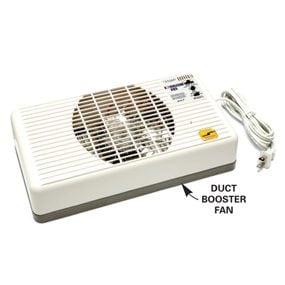Prevent Frozen Pipes With Insulation and Warm Air
Updated: Mar. 31, 2021Rigid insulation is the key

Building an Insulated Chase for Pipes
For starters, forget about using fiberglass or the foam pipe insulation sold at home centers. At best, it provides an insulation value of R-3.8. That’s not enough to prevent frozen pipes during extended cold periods. Plus, it’s difficult to install on existing pipes, especially when the pipes run along the length of a floor joist. So we put our heads together and came up with a solution that can be adapted to most crawlspaces. One of the editors also used this fix to successfully insulate freeze-prone pipes on an outside wall.
Here’s how it works: Build a duct system around the pipes with 2-inch thick rigid extruded polystyrene foam (R-10). It works by drawing heated household air through the foam duct and back into the house. Start by locating a spot near the pipes on one end of the crawl space near a wall and cut a 5 x 10-inch hole in the floor above. This exhaust hole should be near an electrical outlet. Cut another hole at the far end of the pipes to fit a conventional floor vent — the size is up to you.
Next, construct the duct by running the foam down a few inches below the pipes to create enough room for airflow. Glue the lengths together with foam construction adhesive and pin them with screws or nails until the adhesive sets up. Crosscut individual foam pieces to “cap off” any open joist areas. Cutting is easy with a circular or table saw.
Use the same method to encase vertical riser pipes and pipes that run along the length of a joist. Once all pipes are enclosed, glue on end caps.
Buy a duct booster fan (available in the HVAC department at home centers) and place it over the exhaust vent. Run the fan full time at low speed during freezing weather (that’ll only cost a few dollars per month).
CAUTION!
Foam insulation is flammable and produces toxic smoke when burning. You must follow these safety precautions:
- Keep crawl space lights at least 6 feet away from the foam duct.
- Never use electrical heating tape inside the foam duct.
- Do not install a fan inside the duct.
- Do not tap into an existing HVAC duct to supply heat to the foam duct
Required Tools for this Project
Have the necessary tools for this DIY project lined up before you start—you’ll save time and frustration.
- 4-in-1 screwdriver
- Caulk gun
- Circular saw
- Cordless drill
- Jigsaw
- Level
- Safety glasses
- Utility knife
Required Materials for this Project
Avoid last-minute shopping trips by having all your materials ready ahead of time. Here’s a list.
- 2-in. rigid extruded polystyrene foam
- 3-in. nails or screws
- Duct booster fan
- Floor vent
- Foam construction adhesive





